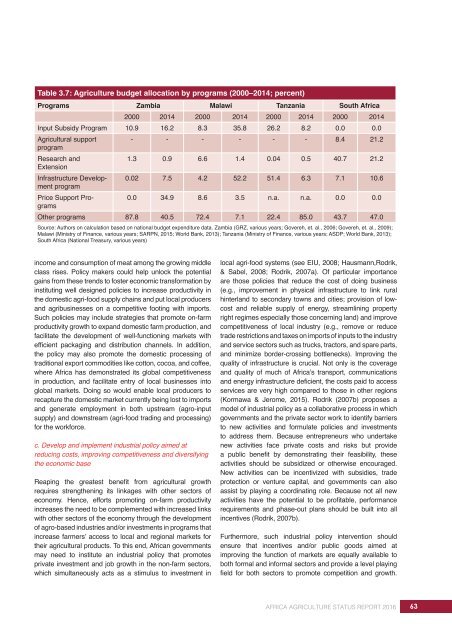AFRICA AGRICULTURE STATUS REPORT 2016
AASR-report_2016-1
AASR-report_2016-1
You also want an ePaper? Increase the reach of your titles
YUMPU automatically turns print PDFs into web optimized ePapers that Google loves.
Table 3.7: Agriculture budget allocation by programs (2000–2014; percent)<br />
Programs Zambia Malawi Tanzania South Africa<br />
2000 2014 2000 2014 2000 2014 2000 2014<br />
Input Subsidy Program 10.9 16.2 8.3 35.8 26.2 8.2 0.0 0.0<br />
Agricultural support<br />
- - - - - - 8.4 21.2<br />
program<br />
Research and<br />
1.3 0.9 6.6 1.4 0.04 0.5 40.7 21.2<br />
Extension<br />
Infrastructure Development<br />
0.02 7.5 4.2 52.2 51.4 6.3 7.1 10.6<br />
program<br />
Price Support Programs<br />
0.0 34.9 8.6 3.5 n.a. n.a. 0.0 0.0<br />
Other programs 87.8 40.5 72.4 7.1 22.4 85.0 43.7 47.0<br />
Source: Authors on calculation based on national budget expenditure data. Zambia (GRZ, various years; Govereh, et. al., 2006; Govereh, et. al., 2009);<br />
Malawi (Ministry of Finance, various years; SARPN, 2015; World Bank, 2013); Tanzania (Ministry of Finance, various years; ASDP; World Bank, 2013);<br />
South Africa (National Treasury, various years)<br />
income and consumption of meat among the growing middle<br />
class rises. Policy makers could help unlock the potential<br />
gains from these trends to foster economic transformation by<br />
instituting well designed policies to increase productivity in<br />
the domestic agri-food supply chains and put local producers<br />
and agribusinesses on a competitive footing with imports.<br />
Such policies may include strategies that promote on-farm<br />
productivity growth to expand domestic farm production, and<br />
facilitate the development of well-functioning markets with<br />
efficient packaging and distribution channels. In addition,<br />
the policy may also promote the domestic processing of<br />
traditional export commodities like cotton, cocoa, and coffee,<br />
where Africa has demonstrated its global competitiveness<br />
in production, and facilitate entry of local businesses into<br />
global markets. Doing so would enable local producers to<br />
recapture the domestic market currently being lost to imports<br />
and generate employment in both upstream (agro-input<br />
supply) and downstream (agri-food trading and processing)<br />
for the workforce.<br />
c. Develop and implement industrial policy aimed at<br />
reducing costs, improving competitiveness and diversifying<br />
the economic base<br />
Reaping the greatest benefit from agricultural growth<br />
requires strengthening its linkages with other sectors of<br />
economy. Hence, efforts promoting on-farm productivity<br />
increases the need to be complemented with increased links<br />
with other sectors of the economy through the development<br />
of agro-based industries and/or investments in programs that<br />
increase farmers’ access to local and regional markets for<br />
their agricultural products. To this end, African governments<br />
may need to institute an industrial policy that promotes<br />
private investment and job growth in the non-farm sectors,<br />
which simultaneously acts as a stimulus to investment in<br />
local agri-food systems (see EIU, 2008; Hausmann,Rodrik,<br />
& Sabel, 2008; Rodrik, 2007a). Of particular importance<br />
are those policies that reduce the cost of doing business<br />
(e.g., improvement in physical infrastructure to link rural<br />
hinterland to secondary towns and cities; provision of lowcost<br />
and reliable supply of energy, streamlining property<br />
right regimes especially those concerning land) and improve<br />
competitiveness of local industry (e.g., remove or reduce<br />
trade restrictions and taxes on imports of inputs to the industry<br />
and service sectors such as trucks, tractors, and spare parts,<br />
and minimize border-crossing bottlenecks). Improving the<br />
quality of infrastructure is crucial. Not only is the coverage<br />
and quality of much of Africa’s transport, communications<br />
and energy infrastructure deficient, the costs paid to access<br />
services are very high compared to those in other regions<br />
(Kormawa & Jerome, 2015). Rodrik (2007b) proposes a<br />
model of industrial policy as a collaborative process in which<br />
governments and the private sector work to identify barriers<br />
to new activities and formulate policies and investments<br />
to address them. Because entrepreneurs who undertake<br />
new activities face private costs and risks but provide<br />
a public benefit by demonstrating their feasibility, these<br />
activities should be subsidized or otherwise encouraged.<br />
New activities can be incentivized with subsidies, trade<br />
protection or venture capital, and governments can also<br />
assist by playing a coordinating role. Because not all new<br />
activities have the potential to be profitable, performance<br />
requirements and phase-out plans should be built into all<br />
incentives (Rodrik, 2007b).<br />
Furthermore, such industrial policy intervention should<br />
ensure that incentives and/or public goods aimed at<br />
improving the function of markets are equally available to<br />
both formal and informal sectors and provide a level playing<br />
field for both sectors to promote competition and growth.<br />
<strong>AFRICA</strong> <strong>AGRICULTURE</strong> <strong>STATUS</strong> <strong>REPORT</strong> <strong>2016</strong><br />
63


